Quick Start
See images of manuscripts
- Mirador - Look for the tabs on the left to see enhancements, interactive texture (WebRTI), transcription, and translations.
- Video tutorials - Learn how to use Mirador to study manuscripts (voice narration over screen capture)
Explore other ways to find a particular manuscript, page, or verse
- Reconstruction of the fifth-century codex of Latin Moses (Jubilees and the Testament of Moses) showing lost and preserved pages with chapter, verse, quire, bifolio, folio, and page numbers
- IIIF Navigator - a simpler, less powerful alternative to Mirador that excels at showing information clearly and cropping for the IIIF Image API
Learn more about Latin Moses (Jubilees and the Testament of Moses)
- About the Jubilees Palimpsest, including English translation of Ceriani’s introduction (1861) and TEI XML of Ceriani’s edition
- The Book of Jubilees in Latin, preprint prepared for Brill, Textual History of the Bible
Learn more about technologies for capture, processing, and publication of advanced images of manuscripts
- Guide to Creating Spectral RTI Images (documentation)
- SpectralRTI_Toolkit GitHub repository
- Spectral RTI (submitted 2017) Preprint prepared for Brill’s Textual History of the Bible
- International Image Interoperability Framework (IIIF) (submitted 2019) Preprint prepared for Brill’s Textual History of the Bible
- Spectral Imaging (submitted 2020) Preprint prepared for Brill’s Textual History of the Bible
- Jubilees Palimpsest Process GitHub repository
News
-
June 12, 2025 - Octopus Lights for Multispectral Imaging -
Another major contribution of the Jubilees Palimpsest Project to the multispectral imaging rodeo is a new way of illuminating manuscripts and other artifacts.
The Octopus lights take their name from the design structure of eight lights controlled by one head.
The feet can be customized and positioned separately, and several heads can be combined in one configuration.

- June 11, 2025 - Multispectral Imaging Networked Capture Controller - One major contribution of the Jubilees Palimpsest Project to the multispectral imaging (MSI) rodeo is a networked capture controller with open-source software to control cameras and lights. Alternative ways of controlling MSI capture rely on Windows software, and generally only work with one or limited configurations. The networked capture controller can be used over a network from any operating system. It has the ability to control all the lights and cameras used in the rodeo with the settings necessary for a level comparison. A description of the device and a link to the GitHub repository of the software is available here
- June 10, 2025 - Multispectral Imaging Component Rodeo - The Jubilees Palimpsest Project is collaborating with Videntes, Rochester Cultural Heritage Imaging, Visualization, and Education, and others to test components useful for multispectral imaging. We are testing equipment at a wide variety of price points, not so much to establish which is better but to evaluate the compromises that come at accessible prices. The comparison, originally scheduled for Colorado with partners in Texas and Oklahoma, is called the multispectral imaging rodeo. The rodeo will take place in Rochester, New York with a public day of demonstrations and presentations on Friday, June 27. Participation is available in person and on Zoom. Registration is required, a donation is optional. Announcement
Older news is available in the News Archive (LINK).
Open Image Repository
Although the Jubilees Palimpsest provided the original impetus for the Jubilees Palimpsest Project, it subsequently became clear that the tools of digital archaeology could have a far greater impact if applied systematically to the tens of thousands of unreadable manuscripts already in libraries and museums. The following palimpsests at the Biblioteca Ambrosiana, particularly those acquired from the Bobbio, have been identified as the top priority for advanced imaging.
Early Judaism and Christianity
- Latin Jubilees (80 pages, LDAB 7663, Mirador), captured 2017
- Testament of Moses (16 pages, LDAB 7663, Mirador), captured 2017
- Arian Commentary on Luke (48 pages, LDAB 7662, Mirador), captured 2017
- Ascension of Isaiah (58 pages, LDAB 7375)
- Gothic Commentary on the Gospel of John / Skeireins (16 pages, LDAB 10984)
- Unidentified Greek Commentary on the Gospel of Luke (210 pages, LDAB 128487, Mirador), five sample pages captured 2017, complete manuscript captured 2023
- Juvencus, Evangeliorum Libri Quattuor (148 pages, E 57 Sup)
Biblical Literature
- Origen, Hexapla (112 pages, O 39 Sup., Mirador), five sample folios (ten pages) captured 2017
- Synoptic Gospels Fragments Palimpsest (32 pages, Q 6 Sup.)
- Ulfila, Gothic Translation of the Book of Nehemiah (6 pages, LDAB 108085)
- Ulfila, Gothic Translation of the Gospel of Matthew (4 pages, J 61 Sup.)
- Ulfila, Gothic Translation of the Letters of Paul including a Gothic Calendar (356 [212 + 144] pages, LDAB 10684 and LDAB 10685, Mirador), twenty sample pages captured 2017
Greek and Roman Literature and Reception
- Bobbio Commentary on Uncertain Work by Cicero (210 pages, LDAB 7372)
- Unidentified Palimpsest in Seventh Century Latin Script (6 pages, LDAB 7688)
- Fronto, Epistles (34 pages, LDAB 7371)
- Symmachus, Orations (62 pages, LDAB 7373)
- Pliny the Younger, Panegyric (0 pages [some portion of the 62 counted above], LDAB 7373)
- Seneca, Medea and Oedipus (10 pages, LDAB 7695)
- Cicero, Fragments (12 pages, LDAB 7713)
- Plautus, Fabulae or excerpt Vidularia (464 pages, LDAB 7693)
We also believe that some items in the collection that are not technically palimpsests could benefit from advanced imaging.
Reconstruction and Edition of Latin Moses (Jubilees and the Testament of Moses)
The Jubilees Palimpsest is named after the oldest of three texts contained in the erased layer of what now stands as a 144-page codex, unbound for conservation. See About the Jubilees Palimpsest for bibliography and links.
 It is possible to reconstruct the fifth-century codex containing Latin Jubilees and the Testament of Moses even though more than half of it is now lost.
For each preserved page we now have advanced spectral images, WebRTI (relightable texture) images, scanned microfilm images (useful for conservation comparison), the transcription offered by Ceriani (1861), and the translation offered by VanderKam (1989).
We also produced an English translation of Ceriani’s introduction in Latin describing the condition of the manuscript and Gryson’s description in French of the codicology of the Arian Commentary on Luke (see About the Jubilees Palimpsest).
This information was used to compose the entry on Latin Jubilees for the Brill Textual History of the Bible
(pre-publisher copy).
It is possible to reconstruct the fifth-century codex containing Latin Jubilees and the Testament of Moses even though more than half of it is now lost.
For each preserved page we now have advanced spectral images, WebRTI (relightable texture) images, scanned microfilm images (useful for conservation comparison), the transcription offered by Ceriani (1861), and the translation offered by VanderKam (1989).
We also produced an English translation of Ceriani’s introduction in Latin describing the condition of the manuscript and Gryson’s description in French of the codicology of the Arian Commentary on Luke (see About the Jubilees Palimpsest).
This information was used to compose the entry on Latin Jubilees for the Brill Textual History of the Bible
(pre-publisher copy).
IIIF Presentation manifests have been created to reconstruct the two older manuscripts erased and resorted to create the eighth century palimpsest, the preserved portion of which is known as Ambrosiana C73 inf. The two older manuscripts are Latin Moses (Jubilees and the Testament/Assumption of Moses) and the Latin (Arian) Commentary on Luke. These manifests can be browsed in Mirador. A paleography chart for Latin Moses is also available.
The next phase of the project will produce a print and interactive online critical edition of Latin Moses, comprising Latin Jubilees and the Testament of Moses. The editions will rely on the Text Encoding Initiative (TEI) to encode all information necessary to derive a IIIF Presentation manifest with annotations for transcription of each line tied to regions of the images. The same TEI file will encode the critical text, translation, apparatus and notes for the print edition, as well as the hypertext digital edition which will more closely follow the features of the manuscript. A two-page sample of the proposed edition is now available (start with Mirador). The previous stable version is also available.
Spectral RTI Technology
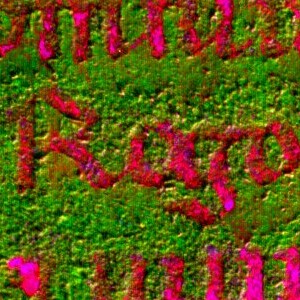
Spectral RTI combines the advantages of spectral imaging (spatial resolution, color spectrum range and resolution, processed enhancements) with the advantages of Reflectance Transformation Imaging (pixel-level texture mapping, interactivity, enhancements). Spectral is helpful for manuscripts because it recovers traces of erased ink indistinguishable to the human eye. Texture mapping is helpful for manuscripts because it can show the outline of an erased letter in the corrosion on the surface of the parchment, as well as other features of accretion (wax, dirt, glue, other deposits) and depression (scores, punctures, dry-point notations).
In 2013–2014 the National Endowment for the Humanities (Digital Humanities Startup Grant) funded a collaboration to test and develop methods to integrate spectral and RTI. The most efficient method uses the standard equipment for spectral and RTI capture and relies on processing to combine the chrominance features of spectral imaging with the luminance features of RTI.
The 2013-2014 Integrating Phase produced:
- A collection of RTI images viewable in WebRTI. The images use the most efficient method of Spectral RTI for objects with varying depths of texture. (LINK). Those images are also available as a IIIF Presentation manifest viewable in Mirador (LINK).
- A twenty-minute video demonstrating the capabilities of Spectral RTI (LINK).
- A summary table demonstrating the most efficient method compared with other experimental methods and each technology individually (LINK).
- For moderately advanced audiences, a detailed white paper describing the experimental methods, our findings, and information to replicate our procedure (LINK).
- For advanced audiences, the complete data set of captured and processed images (LINK).
An implementation grant from National Endowment for the Humanities made the technology accessible to more imaging teams. Major contributions from the 2016-2019 phase include:
- SpectralRTI_Toolkit, a refined Java plugin for ImageJ coded by Bryan Haberberger of the St. Louis University Center for Digital Humanities, available on GitHub.
- Guide to Creating Spectral RTI Images (documentation)
- Spectral RTI (submitted 2017) Preprint prepared for Brill’s Textual History of the Bible
- International Image Interoperability Framework (IIIF) (submitted 2019) Preprint prepared for Brill’s Textual History of the Bible
- Spectral Imaging (submitted 2020) Preprint prepared for Brill’s Textual History of the Bible
- White Paper submitted to the National Endowment for the Humanities detailing all activities and accomplishments.
Standards-Compliant Viewers
The images captured and processed by the project are publicly available (see section on Permissions below) and comply with open standards for viewing and annotation. There are two basic types of images. The first type consists of static images in a repository following the International Image Interoperability Framework (IIIF) standards (Image and Presentation APIs, LINK). The second type consists of interactive relightable texture images (RTI). Additionally, transcription and translation information is provided in XML. For advanced image processing scientists, the raw data archive is available, but that is not recommended for the vast majority of users.
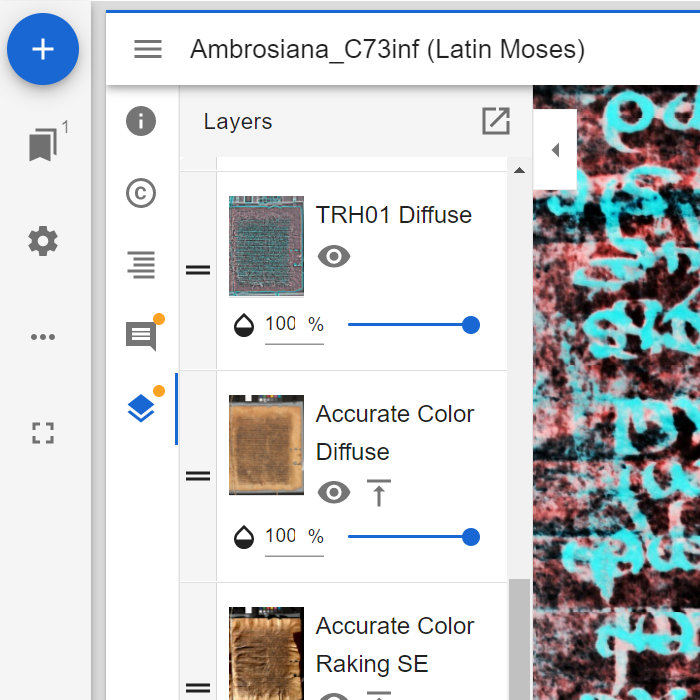 Mirador Viewer includes a side panel that allows users to switch and fade between layers, namely the enhanced color from spectral processing and raking light angles.
For pages from Jubilees, the index tab shows the verse numbers preserved on a page, along with the reconstructed page number of the original fifth-century codex, and the page numbers written on the palimpsest codex in modern times.
The annotations tab shows the resources available, including WebRTI images, transcriptions, translations, and line-by-line transcriptions over the images.
The annotations created by team members can also be accessed in a single page in the
Index of Annotations.
Mirador Viewer includes a side panel that allows users to switch and fade between layers, namely the enhanced color from spectral processing and raking light angles.
For pages from Jubilees, the index tab shows the verse numbers preserved on a page, along with the reconstructed page number of the original fifth-century codex, and the page numbers written on the palimpsest codex in modern times.
The annotations tab shows the resources available, including WebRTI images, transcriptions, translations, and line-by-line transcriptions over the images.
The annotations created by team members can also be accessed in a single page in the
Index of Annotations.
IIIF Navigator, visualizes the same IIIF Presentation manifests. It lacks some advanced features of Mirador, but has some advantages in showing all information available. Based on Leaflet, it seems to perform faster and more reliably on pages with many image layers.
Speed and reliability may also vary between two mirror websites associated with the project. https://jubilees.stmarytx.edu/ is designed for stability and very long-term reliability. It also features advanced caching through Amazon Web Services. https://palimpsest.stmarytx.edu/ is used for development, processing, and the raw data archives. It has more raw power but is susceptible to outages.
Extended Spectrum Processing
Extended Spectrum is a processing technique for spectral imaging captures. It utilizes all the reflectance captures of spectral imaging (including ultraviolet and infrared) and principal component analysis within the three categories of color natural to the human eye. The result is more natural than pseudocolor but simulates what we would see if human color perception had a wider range and higher resolution. The technique divides the spectral captures into three categories: the shortest wavelengths (blueish), the middle wavelengths (greenish), and the longest wavelengths (reddish). Principal Component Analysis finds the greatest contrasts in each of the three categories, which are then mapped to the three channels of an RGB image.
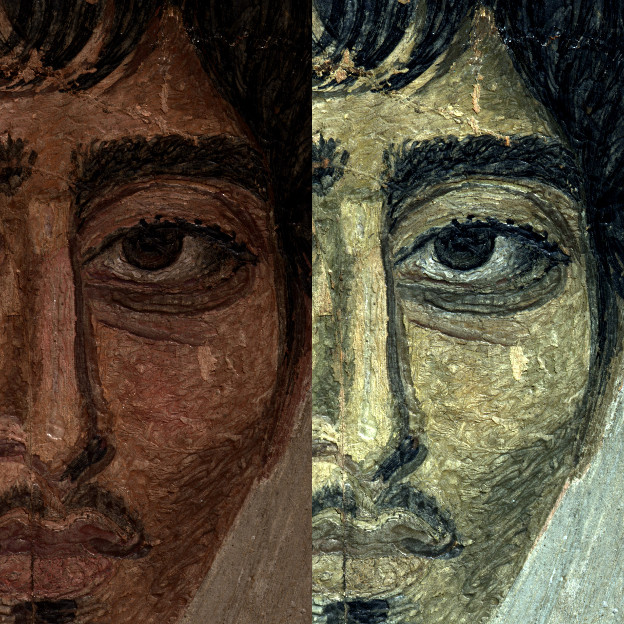
Roman-Period Egyptian Mummy Mask from the USC Archaeological Museum in Accurate Color (left) and Extended Spectrum (right).
About the People Involved in the Jubilees Palimpsest Project

The Jubilees Palimpsest Project was founded and is directed by Todd Hanneken at St. Mary’s University in San Antonio. See the complete list of people involved in various phases of the project.
Funding Partners
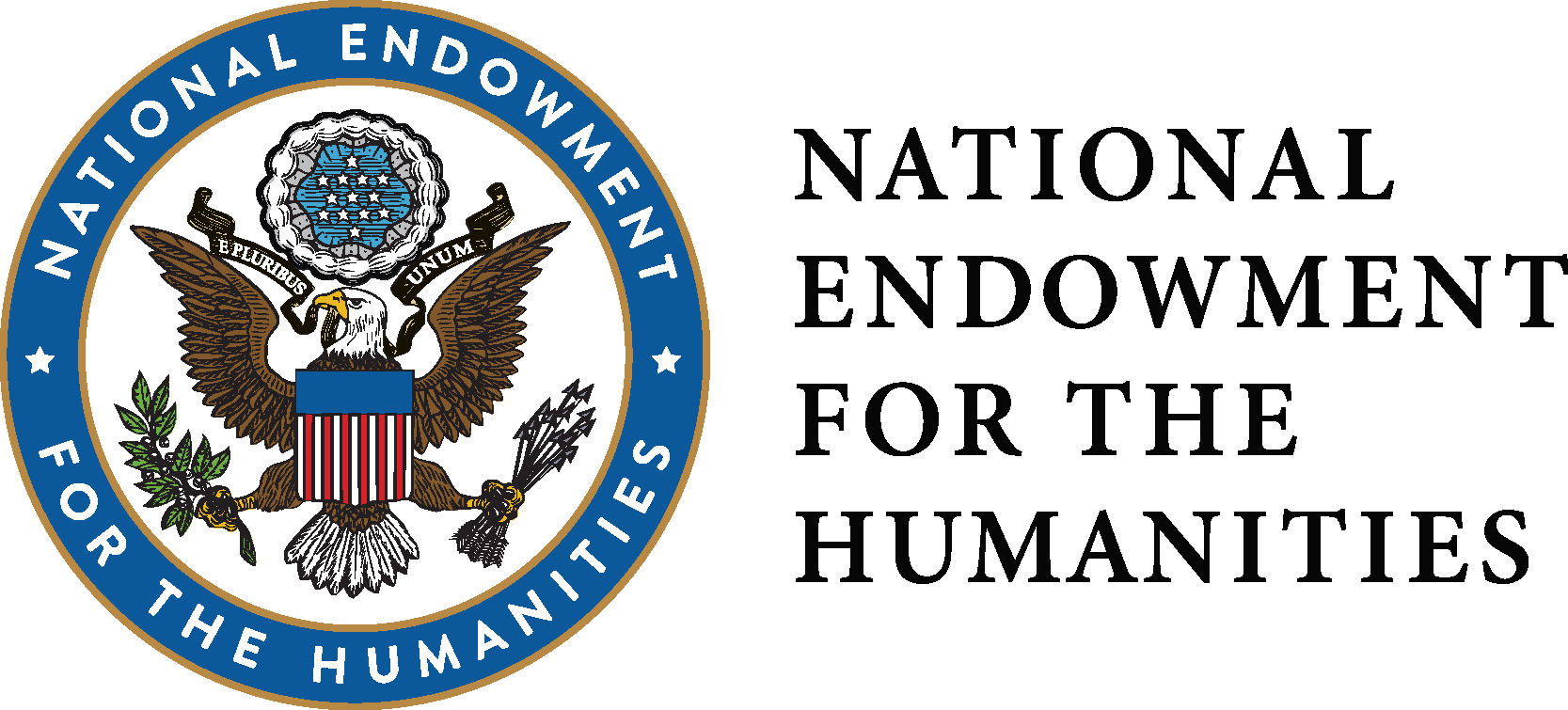
The National Endowment for the Humanities: Celebrating 50 Years of Excellence
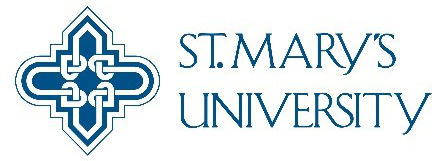
St. Mary’s University, especially the Edward and Linda Speed Fund
Permissions

Image of artifacts from the Biblioteca Ambrosiana can be used and reused under the CC BY-NC-SA license. That means the images can be used as long the sources are attributed, derivatives are shared with the same degree of openness, and no commercial profit is derived from the images. Commercial use of images of artifacts owned by the Biblioteca Ambrosiana must be licensed from the Ambrosiana (not the Jubilees Palimpsest Project). The contact for licensing permission from the Biblioteca Ambrosiana is direzione.biblioteca@ambrosiana.it.

Everything created solely by the Jubilees Palimpsest Project is licensed under the Creative Commons CC BY-SA license. This includes metadata, documentation, and software created by the project. Images of artifacts from U.S.C. and U.C.L.A. are also available under this license.
Attribution should include at minimum the Jubilees Palimpsest Project and the owner of the artifact (e.g., Biblioteca Ambrosiana, U.S.C., U.C.L.A.). If a named author is required use Todd Hanneken or contact the project director for specifics on persons who contributed to creating a particular image.
Some items linked from this site are governed by separate licenses. Examples include the digital versions of public domain books created by Google Books.